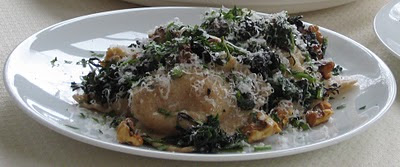 The brilliant thing about risotto, besides the obvious fact that cooking it involves one hand for stirring and leaves the other free to hold a glass of wine, is that it allows you to combine an irresponsibly large number of your favorite ingredients into a single dish. A single awesome, delicious, not-sure-I-actually-made-enough-for-both-of-us-tonight-honey sort of dish.
The brilliant thing about risotto, besides the obvious fact that cooking it involves one hand for stirring and leaves the other free to hold a glass of wine, is that it allows you to combine an irresponsibly large number of your favorite ingredients into a single dish. A single awesome, delicious, not-sure-I-actually-made-enough-for-both-of-us-tonight-honey sort of dish.For instance. I love bacon. Love seems like too mild a word, but we'll go with it. And I love squash. Deeply love. And I've recently been on a southern greens kick. Especially when they're around bacon. And then there are assorted minor ingredients that I feel oddly passionate about, like sage and shallot and lemon zest.
So when I found all these things in my fridge tonight, I had a warm fuzzy feeling that good things were about to happen.
We had baby red mustard greens from our produce box that I added just before the risotto was finished, but if you're using big-leafed greens, it's probably better to add them all earlier, which is what I wrote here. You should be able to substitute or add collard greens. Or throw in some baby arugula near the end...really anything with a little bit of a kick should work well.
Ingredients
2 cups veggie broth (new favorite: Imagine has a mere 9 ingredients, all recognizable, and comes in a low sodium version that avoids the whole wildly oversalted risotto thing)
Olive oil
Rounded 1/2 cup chopped shallot
1 cup Arborio rice
2 cups diced winter squash (heirloom or butternut)
White wine
Several big handfuls of turnip and mustard greens, sliced or chopped
1 tbsp sage that's been sliced crosswise into thin ribbons
2 strips Niman Ranch applewood smoked bacon (else pancetta), cut crosswise into strips
Zest of 1 lemon
Coarsely ground black pepper
1/4 cup freshly grated Parmesan Reggiano
Heat broth in a small pot over medium heat until it simmers, then turn off heat and leave covered to keep warm.
In a large pot, heat a glug of olive oil over medium heat. Add the shallot and saute for several minutes until soft, then add the rice and squash and stir to coat evenly. Cook, stirring occasionally, for about three minutes (the mixture should start to smell fragrant and toasty). Add a ladleful of white wine and continue to cook, stirring, until the liquid has been absorbed. Start adding the broth, a ladleful at a time, stirring occasionally and allowing it to be absorbed each time before adding more. After the second ladleful of broth, add the greens to the rice, and continue cooking as before.
When the rice is almost tender, heat a small pan over medium high heat, add the bacon, and cook until lightly brown on all sides. Add the sage, stir once or twice, and turn off the heat. Drain most (but not all) of the excess bacon grease out of the pan.
When the rice is tender (which should be just about when all the broth has been added), toss in the lemon zest, pour in the bacon-sage mixture, and sprinkle liberally with freshly ground black pepper. Stir together, and turn off the heat. Add the parmesan, stir, and serve hot.
 Serves 2-3.
Serves 2-3.Tip: If your risotto has to sit for awhile, because, for example, one person in your party was unavoidably detained at the hospital despite ASSURING you that he would be back momentarily, or because you put it in the fridge to have leftovers the next day, you can reconstitute it by adding a little bit of broth before reheating (it tends to dry out when it sits for too long, but perks back up with a little more broth).
















